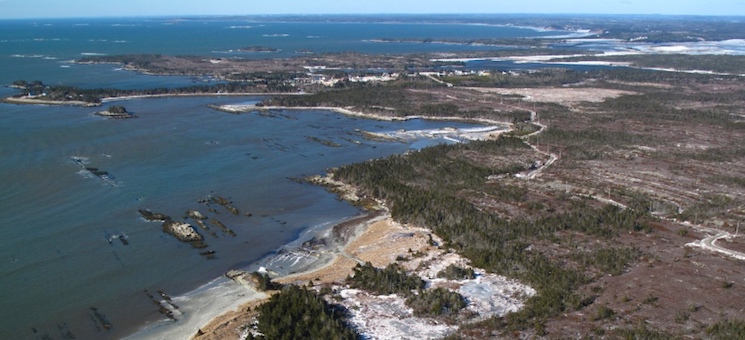Let The Owls Head Proponents Make Their Case

Posted March 19, 2021
The 2017 mandate letter from then Premier Stephen McNeil to then Environment Minister Iain Rankin is the most up-to-date version as of March 19th. It instructed him to consider both the economy and the environment in exercising his responsibilities:
“I ask that the department continue to support a business environment which is conducive to innovation and economic development, striking the right balance, ensuring that effective regulation protects the interests of Nova Scotians while enhancing our provincial prosperity.”
This made it possible to consider resource-based industries that bring well-paying jobs to rural Nova Scotia: mining, aquaculture, wind turbines, and forestry—subject in every case to review through an environmental lens.
Things did not always go industry’s way—hence the extremely difficult but necessary decision to shut down the effluent discharge at Boat Harbour, and the paper mill it serviced. This hurt both mill workers and those who provide the raw material from forests.
The good performance of the Nova Scotia economy is due in part to the growth of resource industries. They are essential to much of rural Nova Scotia’s viability.
In 2019, Rankin, then Lands and Forestry Minister, delisted 285 hectares of Crown property and entered into sale negotiations with Lighthouse Links Development, which owned 138 adjacent hectares, want to build two or three 18-hole golf courses in the Little Harbour area.
Any such development would be subject to normal environmental review.
Environmentalists have attacked the project on two fronts. A lawsuit that goes before a judge on April 1st argues that the government should have consulted the public before deciding to delist the property.
At the same time, a batch of letters to the editor argue that the project should be pre-emptively shelved. Some of them are not well informed.
The authors claimed that Nova Scotia does not have enough room for more golf courses, that the proposed location is too rocky for a golf course, that the proposed price was too low, that building a golf course on the rocky terrain will cause catastrophic environmental damage.
Nova Scotia has 131 operational provincial parks occupying 21,000 hectares. The two national parks occupy a further 135,000 hectares.
A golf course occupies 50-75 hectares depending on how much of the land is usable. The area of Nova Scotia is 5,528,400 hectares. The 65 courses we already have use less than 0.1% of the total.
Combining holdings at Owls Head would provide 438 hectares. Three golf courses would use at most half of that, leaving plenty of opportunity to protect areas having unique environmental attributes. Any proposal by Lighthouse Links would be subject to environmental review.
Nova Scotia has no shortage of rocky terrain. People have differing tastes. Many would be happier walking on a golf fairway than clambering over rocks. It is certain that far more people will enjoy the view from Owls Head if it has golf courses than if it remains as is.
Because of COVID restrictions, outdoor recreation activities surged in 2020 and will continue to be strong in 2021. Golf was one of the beneficiaries and many courses were often running at capacity. Courses employ people for grounds and facility maintenance, managing tee times, retail sales, and restaurants.
Cabot Links and Fox Harb’r are special cases. Built entirely with private money (a loan to Cabot has been fully repaid), they are magnets for thousands of out-of-province tourists who need onsite accommodation. In addition to hundreds of seasonal jobs, both resorts have become significant real estate developments, providing year-round construction employment.
Beyond that, they draw visitors to other fine courses such as Highland Links, Northumberland Links, and many others.
Inverness was in terminal decline prior to Cabot. Now it is a bustling town in season. Fox Harb’r employs people from all over Cumberland and Colchester counties.
Creating three courses and the associated accommodations at Owls Head would keep builders busy for years. The private investment will be in the tens of millions. A petition to move the project forward was signed by 758 local residents.
With its strong cultural resources, Nova Scotia can aspire to compete with Scotland for golf tourism. Having world-class golf destinations adds to the province’s attractiveness for immigrants from other provinces and countries.
The letter writers imply that Rankin will have trashed his green credentials if he allows the golf project to proceed. No doubt that will also be said if he fails to shut down marine-based finfish aquaculture, gold mines, and much of the forest industry.
Rankin was asked about Owls Head for this column in December. Noting the significant level of local support, he stated that an environmentally sensitive proposal for a golf resort at Owls Head could be approved.
Allowing the proponents to present their proposal for consideration by the Department of Environment was the right position then and is the right position now.
Related Articles
Chasing the Jobs- When Will Our Politicians Be Honest About The Economics Of The Yarmouth Ferry? August 18, 2023
- First Nations Fishing Rights Are Best Realized Through Cooperation, Not Conflict November 6, 2020
- Who Would Pay For The Guaranteed Basic Income? You May Be Surprised August 14, 2020

Cancel reply